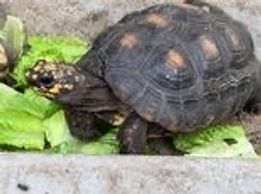Meet Our Current Reptile Residents
OUr Resident SUlcata Tortoises
African Spur AKA Sulcata tortoises live in the southern edge of the Sahara Desert, and the Sahel region of Africa.
Atlas - Our Largest Salcata Tortoise
Ireland - The Smaller Of The Big Sulcata Tortoises
Ireland - The Smaller Of The Big Sulcata Tortoises

Atlas joined us in December of 2024.
Ireland - The Smaller Of The Big Sulcata Tortoises
Ireland - The Smaller Of The Big Sulcata Tortoises
Ireland - The Smaller Of The Big Sulcata Tortoises

Ireland joined our sanctuary in the summer of 2024
Torti - Our Smallest Salcata Tortoise
Ireland - The Smaller Of The Big Sulcata Tortoises
Torti - Our Smallest Salcata Tortoise

Torti joined out sanctuary in 2022. Don’t let the photo fool you, he has definitely grown since his arrival!!!
Hamburg - Sulcata Tortoise
Hamburg - Sulcata Tortoise
Torti - Our Smallest Salcata Tortoise

Hamburg came into our sanctuary along with 4 other red-footed tortoises in the fall of 2025. She is a smaller gal, but not as small as torti!!
Aslan - Sulcata Tortoise
Hamburg - Sulcata Tortoise
Aslan - Sulcata Tortoise

Aslan joined our sanctuary in October of 2025. He is one of our larger size Sulcata tortoises.
OUR resident red-footed tortoises
Red-Footed Tortoises live throughout south America from Panama to Argentina. They are also found on the Caribbean islands of Trinidad and Barbados.
AMAZON - RED- FOOTED TORTOISE
COLUMBIA - COLUMBIAN RED-FOOTED TORTOISE
COLUMBIA - COLUMBIAN RED-FOOTED TORTOISE

Amazon joined us before we even created Gulf Winds Wildlife Sanctuary. He joined us in 2021 as a rescue along with 2 small birds.
COLUMBIA - COLUMBIAN RED-FOOTED TORTOISE
COLUMBIA - COLUMBIAN RED-FOOTED TORTOISE
COLUMBIA - COLUMBIAN RED-FOOTED TORTOISE

Columbia came to us years before we formed Gulf Winds Wildlife Sanctuary. She along with her sister have been with us since 2019.
BOLIVIA - COLUMBIAN RED-FOOTED TORTOISE
COLUMBIA - COLUMBIAN RED-FOOTED TORTOISE
BOLIVIA - COLUMBIAN RED-FOOTED TORTOISE

Bolivia has been with us since before we formed Gulf Winds Wildlife Sanctuary. She along with her sister have been with us since December of 2019.
Red - Red-footed tortoise
BOLIVIA - COLUMBIAN RED-FOOTED TORTOISE

Red came into our sanctuary along with 3 other Red-Foted tortoises and Hamburg the Sulcata
Red-footed tortoise
Brizilian Cherry Head TOrtoise

came into our sanctuary along with 3 other Red-Foted tortoises and Hamburg the Sulcata
Brizilian Cherry Head TOrtoise
Brizilian Cherry Head TOrtoise

came into our sanctuary along with 3 other Red-Foted tortoises and Hamburg the Sulcata
Brizilian Cherry Head TOrtoise
Brizilian Cherry Head TOrtoise
Brizilian Cherry Head TOrtoise

came into our sanctuary along with 3 other Red-Foted tortoises and Hamburg the Sulcata
OUR resident Burmese Mountain tortoises
Burmese Mountain Tortoises originate from the Forrest of southeast Asia. specifically across a range that includes India (Assam), Bangladesh, Myanmar (Burma), Thailand, Malaysia, Sumatra, and Borneo.specifically across a range that includes India (Assam), Bangladesh, Myanmar (Burma), Thailand, Malaysia, Sumatra, and Bo
burney - Burmese Brown mountain tortoise
toothless - Burmese black mountain tortoise
toothless - Burmese black mountain tortoise

Burney joined our sanctuary in 2025 as a hatchling.
toothless - Burmese black mountain tortoise
toothless - Burmese black mountain tortoise
toothless - Burmese black mountain tortoise

Toothless joined our sanctuary in 2025 as a hatchling.
DID YOU KNOW.....

ENdangerment status of our tortoise
Our Columbian Red-Footed Tortoises (Chelonoidis carbonarius) are listed as vulnerable on the INUC red list conservation status. This is due to habitat destruction, hunting, and captivation for the pet trade.

EVery species of tortoise needs a different diet.
Tortoises come from many different areas around the world, so they each require a special diet that fits their individual needs. Take for example the red-footed tortoise and the Sulcata tortoise. The red-footed tortoise need fruit everyday, while the Sulcata tortoise would develop pyramiding from the high sugar in fruity.

TOrtoises need ponds to soak in.
Tortoises can hydrate 2 different ways. One way is like us, drinking water. The other was is by soaking the underside (soft part) of their body in a pond. Tortoises can also separate the liquid and solid waste products in their system. This way if they feel they are in a drought that can retain the liquids in their bodies.

An incorrect diet or habitat will harm your reptile.
Metabolic bone disease, also known as nutritional secondary hyperparathyroidism, is one of the most common diseases of pet reptiles. It’s a disease that affects the skeletal system, causing weak, rubbery, and easily broken bones. Metabolic bone disease (MBD) occurs if a pet reptile has abnormal calcium, phosphorus, and vitamin D3 levels, either caused by a poor diet or poor care. Veterinarians diagnose MBD most often in lizards, turtles, and tortoises, but can also be found in amphibians and snakes. One sign of MBD in tortoises in pyramiding of the shell like in the photo shown.
This website uses cookies.
We use cookies to analyze website traffic and optimize your website experience. By accepting our use of cookies, your data will be aggregated with all other user data.
